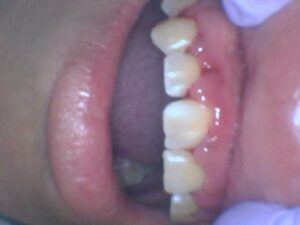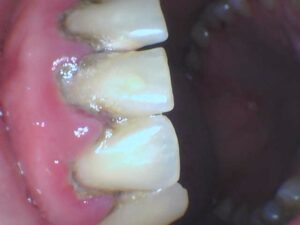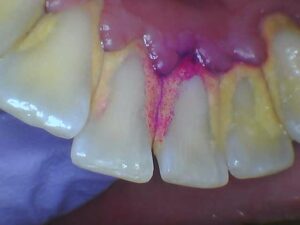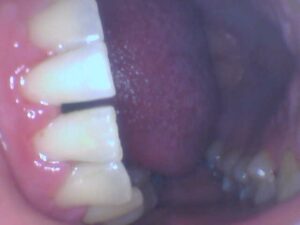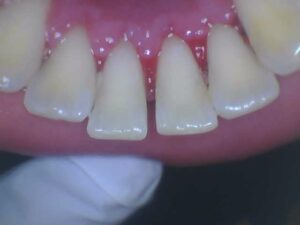Case Study 2: Heart Murmur and HBP
Initial Visit:
The patient under examination was a 27-year-old Hispanic male. The patient’s initial blood pressure was 138/89 (corresponds to HBP Stage I) Pulse 72. Based on the patient’s medical history provided, it was revealed that the patient had a surgical procedure at birth due to being born prematurely for a congenital heart defect – heart murmur. Presented symptoms were shortness of breath but no medication was indicated for this systemic condition. The patient reported to have had a medical exam for their eyes during December 2023 and they currently take Latanoprost (used to treat certain types of glaucoma and other causes of high pressure inside the eye, dosage is 0.005, every night -one drop per eye). The patient reports no alcoholic consumption, smoking, or use of substances. The patient reports to have had a cleaning 2 years ago and a PANO done. The patient experiences sensitivity to cold mainly around his back teeth and experiences bad breath. The patient’s oral hygiene regimen consists of an electric toothbrush, brushed twice daily, Colgate whitening, Listerine (non-alcohol), a water pik, and a tongue scraper.
An extra-oral and intra-oral examination showed that the patient had mandibular exostosis, submandibular swelling, redness in the tonsillar area, and a white coating on the tongue, in addition to 1-2 mm papules surrounding the chin (which the patient reported having recently, and the previous dentist had informed the patient of the findings).The patient also had multiple suspected caries lesions along with a composite seen on #14 (O). The patient presented with a class III occlusion. The patient presented with generalized red irregular gingival margins with areas of bulbous friable interdental papilla; Interdental papilla fits interproximally with shiny, inflamed areas with generalized bleed upon probing. Upon probing examination, the patient presented with generalized 4-5mm PD with areas of 6-7mm PD on the posterior region with areas of generalized 1-2mm recession on the lower anteriors on the facial and lingual aspects.
The patient’s original treatment plan consisted of three visits including the initial visit. As the plaque index score we conducted was 1.8, a poor range, and the biofilm primarily appeared on the cervical third of the tooth and interproximally, we started giving oral hygiene instructions and concentrated on the spool method. The Spool Method was initially taught since it was seen that the patient’s buildup was primarily concentrated in the spaces between their teeth and that, according to their reported hygiene routine, flossing was not included in it. The patient was administered Oraqix for Q1 following a discussion and demonstration of education. Q1 was manually scaled and scaled with a cavitron tip.
Revisit #1:
During the revisit, we retook the patient’s BP and it was 140/99 (corresponds to HBP Stage II) Pulse 100 (which was taken at 8:10 AM). We waited for 5 minutes before retaking the 2nd BP measure which came out to be 119/99 (correspondence to HBP Stage II). With faculty approval, we proceeded with treatment. Upon extra-oral and intra-oral re-evaluation, no new significant findings were present. Upon re-examination of the area scaled, the patient presented with generalized light pink marginal gingiva with areas of rolled margins on the lingual aspect with decreased inflammation but still had areas of redness. The plaque score was not changed and the Modified Bass method was demonstrated. The patient felt comfortable with the technique and reported that they would attempt to use it in their daily routine. The patient received Oraquix administration on Q2, Q3, and Q 4. Q2, 3, and 4 received mechanical scaling and the use of a cavitron tip. The patient asked to depart as quickly as possible, therefore fluoride treatment and engine polishing were not performed. It was advised that the patient return for a three-month recall.
A horizontal bitewing was performed which revealed no calculus, no inter-proximal caries seen, and generalized 10% horizontal bone loss on the posterior region (done at the end of the treatment). Upon all findings, a classification for periodontal status was stated as severe gingivitis.
BEFORE:
AFTER:
